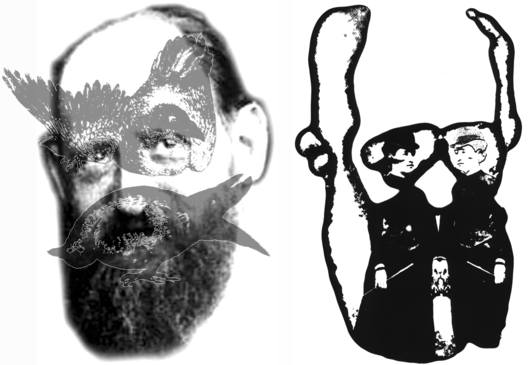Josef Breuer1842–1925
Breuer interested Sigmund Freud in hysteria by discussing one of his cases with him. However, before his limited excursion into the study of mental illness, Breuer had earned an independent reputation in physiology and medicine. His work with Hering, on the reflex regulation of respiration, is marked by the Hering-Breuer reflex. Receptors in the lungs respond to the extent of stretching and signal this to the brain via the vagus nerve setting in train a feedback control of respiration. In 1875 following this research he established, simultaneously with Mach and Crum Brown, the function of the semi-circular canals. During head rotation the endolymph in the canals displaces receptors in the ampulla, signalling angular accelerations and exerting control over posture and eye movements. Breuer also distinguished between the canal receptors and the otolith organs of the vestibular system, which detected orientation with respect to gravity. He followed in the tradition of Flourens by making systematic lesions of the semicircular canals of pigeons. He also examined the effects of body rotation on eye movements. Most of his experimental work was conducted at his practice in Vienna – even his experiments on vestibular function in pigeons. He is shown, on the left, with images of disorientated pigeons following vestibular lesions. Nonetheless, he is probably known most widely for his collaboration with Freud. Anna O (Bertha Pappenheim, 1860-1936) is perhaps one of the most celebrated patients in psychopathology; her case was very complex and, despite Breuer’s acute powers of observation, was probably made more so as a consequence of its retrospective reconstruction. Breuer treated Anna O from 1880 until 1882, and described four phases through which her mental illness passed. All involved two distinct states of consciousness. During the late evening she was rational whereas during the day she suffered from paralyses and contractures, ocular disturbances, speech difficulties, and hallucinations. The transition between the two conditions took place in the late afternoon. She then went into a spontaneous hypnotic state from which she emerged with an almost normal second personality. Breuer found that her symptoms could be relieved (although not permanently removed) by talking in great detail about the origins and appearances of each of them. This constituted Breuer’s talking cure. During hypnosis Breuer would “ask her to concentrate her thoughts on the symptom we were treating at the moment and tell me the occasions on which it had appeared. The patient would proceed to describe in rapid succession and under brief headings the external events concerned and these I would jot down”. Anna’s case, together with others treated by Freud, was published in their Studies of Hysteria (1895); the theoretical chapter was written by Breuer, who can be credited with linking neuroses to unconscious processes and with developing a technique to render the unconscious processes conscious. Although it is not known how, Anna O recovered from her neurosis and embarked on an active life supporting social and religious causes. Breuer was born in Vienna, studied medicine at its University and had a thriving medical practice there; Freud was one of his patients. On the right, Breuer is depicted in combination with two views of Anna O reflecting her dual personality.
